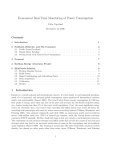Download Research Grade Isotonic Transducer User`s Manual
Transcript
Research Grade Isotonic Transducer User's Manual Research Grade Isotonic Transducer, 110 VAC/60 Hz MA1 60-3000 Research Grade Isotonic Transducer, 220 VAC/50 Hz MA1 60-3001 Publication 5408-003-REV-A WEEE/RoHS Compliance Statement EU Directives WEEE and RoHS To Our Valued Customers: We are committed to being a good corporate citizen. As part of that commitment, we strive to maintain an environmentally conscious manufacturing operation. The European Union (EU) has enacted two Directives, the first on product recycling (Waste Electrical and Electronic Equipment, WEEE) and the second limiting the use of certain substances (Restriction on the use of Hazardous Substances, RoHS). Over time, these Directives will be implemented in the national laws of each EU Member State. Once the final national regulations have been put into place, recycling will be offered for our products which are within the scope of the WEEE Directive. Products falling under the scope of the WEEE Directive available for sale after August 13, 2005 will be identified with a “wheelie bin” symbol. Two Categories of products covered by the WEEE Directive are currently exempt from the RoHS Directive – Category 8, medical devices (with the exception of implanted or infected products) and Category 9, monitoring and control instruments. Most of our products fall into either Category 8 or 9 and are currently exempt from the RoHS Directive. We will continue to monitor the application of the RoHS Directive to its products and will comply with any changes as they apply. • Do Not Dispose Product with Municipal Waste • Special Collection/Disposal Required Table of Contents Harvard Apparatus Research Isotonic Transducer User ’s Manual 1 SUBJECT PAGE NO. Warranty and Repair Information ........................2 Theory of Operation ..............................................3 General Information: Specifications......................................................4 Amplifier/Power Supply ......................................4 Internal Controls and Adjustments ....................5 Electrical Output ................................................5 Maintenance and Storage ..................................5 Serial Number ....................................................5 Operations: Transducer Setup ..............................................6 Smoot Muscle/Isolated Organ Preparation ........7 Skeletal Muscle Preparation ..............................8 General Information 2 Harvard Apparatus Research Isotonic Transducer User ’s Manual Serial Numbers All inquires concerning our product should refer to the serial number of the unit(s). W a rr a n t y Harvard Apparatus warranties the instrument(s) for a period of two years from date of purchase.At its option, Harvard Apparatus will repair or replace the unit(s) if it is found to be defective as to workmanship or material. This warranty does not extend to damage resulting from misuse, neglect or abuse, normal wear and tear, or accident. This warranty extends only to the original customer purchaser. IN NO EVENT SHALL HARVARD APPARATUS BE LIABLE FOR INCIDENTAL OR CONSEQUENTIAL DAMAGES. Some states do not allow exclusion or limitation of incidental or consequential damages so the above limitation or exclusion may not apply to you. THERE ARE NO IMPLIED WARRANTIES OF MERCHANTABILITY, OR FITNESS FOR A PARTICULAR USE, OR OF ANY OTHER NATURE. Some states do not allow this limitation on an implied warranty, so the above limitation may not apply to you. If a defect arises within the two-year warranty period, promptly contact Harvard Apparatus, Inc. 84 October Hill Road, Holliston, Massachusetts 01746-1371 using our U.S. only toll free number 1-800-272-2775 or dial (508) 893-8999. Goods will not be accepted for return unless an RMA (returned materials authorization) number has been issued by our customer service department.The customer is responsible for shipping charges. Please allow a reasonable period of time for completion of repairs, replacement and return. If the unit is replaced, the replacement unit is covered only for the remainder of the original warranty period dating from the purchase of the original device. This warranty gives you specific rights, and you may also have other rights which vary from state to state. R e p a i r F a c i l i t i e s a n d P a rt s Harvard Apparatus stocks replacement and repair parts. When ordering, please describe parts as completely as possible, preferably using our part numbers. If practical, enclose a sample or drawing.We offer a complete reconditioning service. CAUTION: Not for clinical use on human patients. Theory of Operation Harvard Apparatus Research Isotonic Transducer User ’s Manual 3 This Isotonic Transducer converts rotary motion into a proportional DC voltage. A moveable capacitor plate attached to the rotating shaft and fixed capacitor plates form a differential capacitor. A patented electronic circuit, (U.S. Patent #4142144) transforms capacitance change linearity into a DC voltage equal to 2.0 volts for 15° of rotation. The use of the capacitance principle produces the following advantages: 1) Extremely low moment of inertia of 0.36 cm which is an order of magnitude better than comparable units. This low inertia insures that complex quick changes are faithfully reproduced. 2) Excellent linearity of ±1%. 3) High voltage output, ±2.0 volts. 4) Excellent stability and freedom from drift. + voltage 0° = 0 voltage – voltage Signal Cable Power Supply ISOTONIC TRANSDUCER VOLTS OUTPUT 12 Volt AC Wall Transformer 12 Volt AC Cable Binding Posts Figure 1. Research Grade Isotonic Transducer Low-Gain Trim Offset Trim _ + General Information Harvard Apparatus Research Isotonic Transducer User ’s Manual 4 Specifications Linearity ±1% Moment of Inertia 0.35 g•cm, without hardware Breakaway Torque 0.05 g•cm Accuracy ±1% Rotation ±15° Output ±2.0 VDC for ±15° rotation Sensitivity 1 minute of arc Output Impedance 2 kΩ Amplifier/Power Supply a) The entire transducer is powered by a 12 volt AC wall transformer. b) There is no ON/OFF switch. The unit can remain powered, as shown on the digital meter, for the entire experiment. Signal Cable Power Supply ISOTONIC TRANSDUCER VOLTS OUTPUT 12 Volt AC Wall Transformer 12 Volt AC Cable Figure 1.Amplifier/Power Supply General Information 5 Harvard Apparatus Research Isotonic Transducer User ’s Manual I n t e r n a l C o n t ro l s a n d A d j u s t m e n t s On the rear panel of the power supply are three small access holes to the trim pots. The GAIN trim pot is accessed through the center hole and is factory set to deliver 2.0 VDC for 15° of rotation. It can be adjusted to deliver between 1 – 3 volts output for 15° of rotation. The OFFSET adjustment trim pot is located on the extreme left and has been factory adjusted so that when the flat of the shaft is horizontal, output is zero volts. This can also be user adjusted as required.The right hole is not used. Electrical Output a) Binding post are provided on the power supply for output connections. Red is positive (+); black is negative (–) and also ground. b) Output voltage is ±2.0 VDC for rotation up to ±15°. Output impedance is 2 kΩ for direct connection to all recorders. Binding Posts _ Gain Trim + Offset Trim To Transducer Sensing Head 12 Volt AC input Figure 2. Electrical Output Maintenance and Storage a) No special precautions are required other than preventing corrosive solutions from entering the space where the output shaft exits the transducer. b) When not in use, store in a clean, dry place. Serial Number The serial number is located on the power supply circuit board. Refer to this number in any correspondence. Operations 6 Harvard Apparatus Research Isotonic Transducer User ’s Manual Tr a n s d u c e r S e t u p This transducer is supplied with complete hardware to set up the transducer for smooth muscle, isolated organ, or exposed heart applications including bio-assay techniques in an organ bath, or skeletal muscle experiments such as the muscle twitch using the frog gastrocnemius preparation. The stainless steel mounting rod of the transducer should be securely fastened to a rigid stand for optimal use. It should be noted that maximum sensitivity to muscle movement occurs when the string connected to the muscle is closest to the rotating shaft. In this position, small movements create larger angular motion (see Fig. 1). When the lever is horizontal and in the same plane as the handle, the electrical output is zero (see Fig. 1). Clockwise rotation produces a positive voltage whereas counterclockwise rotation produces a negative voltage. The protecting ears of the handle bracket limit rotation to ±18°. In addition, there are internal limit stops. Nylon Screw Rotating Shaft Lever Arm + voltage Mounting Rod 0° = 0 voltage – voltage Figure 3. Transducer Setup Operations 7 Harvard Apparatus Research Isotonic Transducer User ’s Manual S m o o t h M u s c l e / I s o l a t e d O r g a n P re p a r a t i o n For smooth muscle or isolated organs preparations, the following items will be used: 1) Simple Wooden or Aluminum Levers 2) Lever-Holding Clamp To use the levers, the lever-holding clamp is attached to the shaft of the transducer using the Allen wrench provided. Make sure that the set screw seats on the flat portion of the shaft. The clamp must be attached to the shaft so that the Allen screw seats on the flattened portion of the shaft. The wooden or aluminum lever is passed through the hole in the clamp and is held in place by the spring of the clamp (see Fig. 2). Nylon Screw Allen Screw Mounting Rod + voltage Lever Arm (Aluminum or Wood) 0° = 0 voltage – voltage Lever Clamp Figure 4. Smooth Muscle/Isolated Organ Preparation Operations 8 Harvard Apparatus Research Isotonic Transducer User ’s Manual S k e l e t a l M u s c l e P re p a r a t i o n For skeletal muscle contraction the following items will be used: 1) Muscle Lever 2) After Loading Screw and Spring 3) Scale Pan 4) Weights Install after loading screw and spring as shown (see Fig. 3). Using an Allen wrench, install muscle lever so that Allen screw bears on shaft. Attach double hook to one of the two positions on the muscle lever and add the scale pan (see Fig. 3). Mounting Rod After Loading Screw & Spring Rotating Shaft Lever Arm + voltage 0° = 0 voltage Scale Pan – voltage Weights Figure 5. Skeletal Muscle Preparation





















